
- SAP Community
- Products and Technology
- Technology
- Technology Blogs by Members
- abap2UI5 - (10) Extensions I: Exploring External L...
- Subscribe to RSS Feed
- Mark as New
- Mark as Read
- Bookmark
- Subscribe
- Printer Friendly Page
- Report Inappropriate Content
So far, we've focused on utilizing standard UI5 controls and primarily adopting UI5 samples for integration with abap2UI5. However, we also have the opportunity to use third-party libraries or harness native device capabilities at the frontend. This includes functionalities like barcode scanning, image capture, and geolocation services. In this blog, we will delve into these advanced features and their integration with abap2UI5
All demos showcased in this blog are ready for use and can be easily tried out by installing the abap2UI5-samples with abapGit.
Blog Series & More
Find all the information about this project on GitHub, stay up-to-date by following on Twitter and exploring the other articles of this blog series:
Content
This article covers the following areas:
- Displaying Barcodes with bwip-js
- Scanning Barcodes with the UI5 Barcode Scanner
- Reading Frontend Information (UI5 Version, Device Information etc.)
- Reading Geolocation & Visualizing with the UI5 Map Container
- Capturing Pictures and Sending them to the Backend
- Highlighting & Providing Contextual Help with driver.js
- More Libraries (FontAwesome, ImageMapster...
Let's begin with the first topic:
(1) Display Barcodes with bwip-js
There are numerous libraries available for rendering barcodes at the frontend. For this example we use the open-source framework bwip-js, although other libraries could also be suitable. You can explore the repository here and view a demo of all its capabilities at this link.

JavaScript Framework bwip-js
Many types of barcodes are available, and you can find a list of all supported barcode types here:
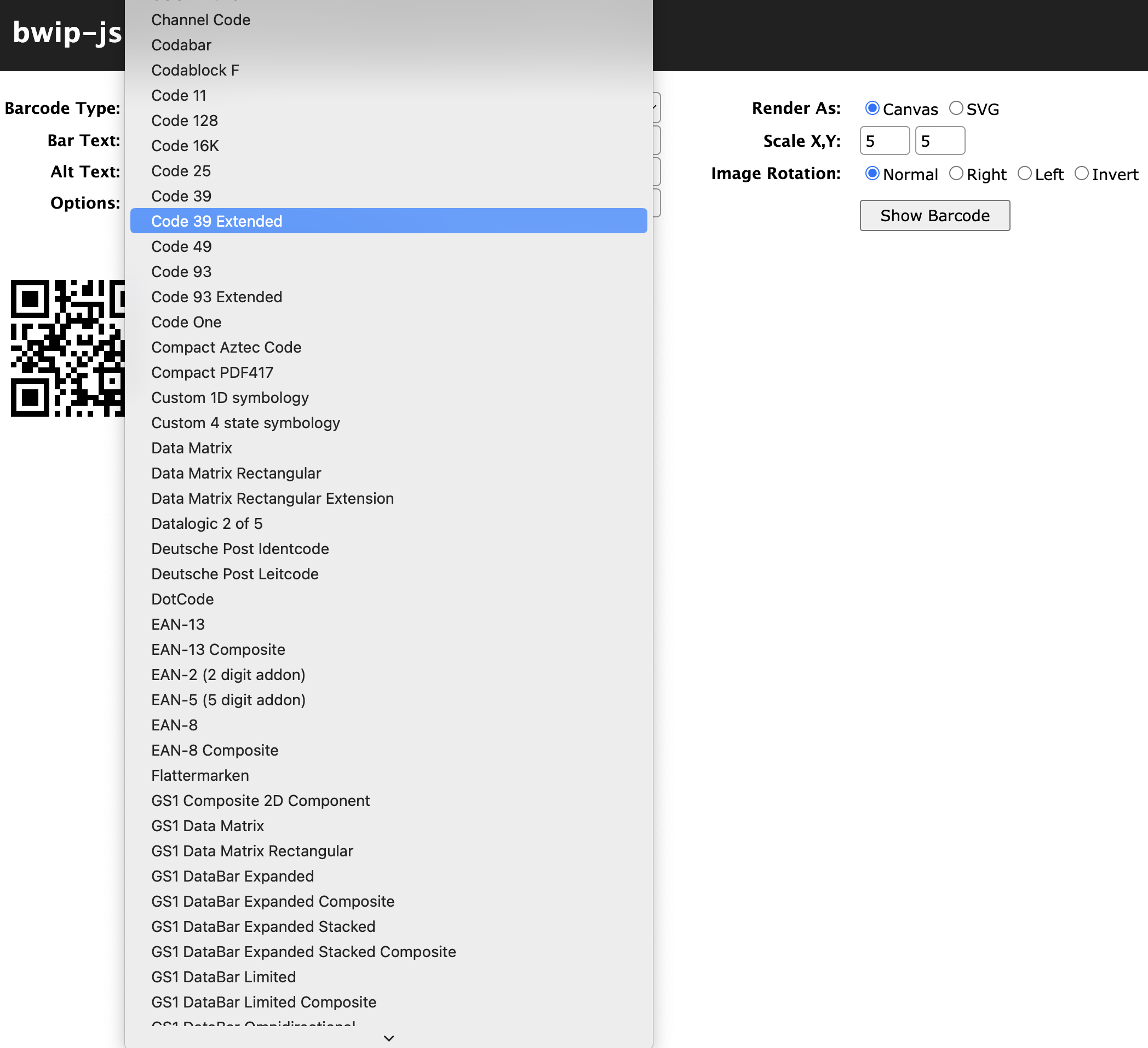
Supported Barcodes of bwip-js
To use this library in abap2UI5, the functionality is encapsulated within a custom control. You can view the source code here. The output of the demo app looks like this:
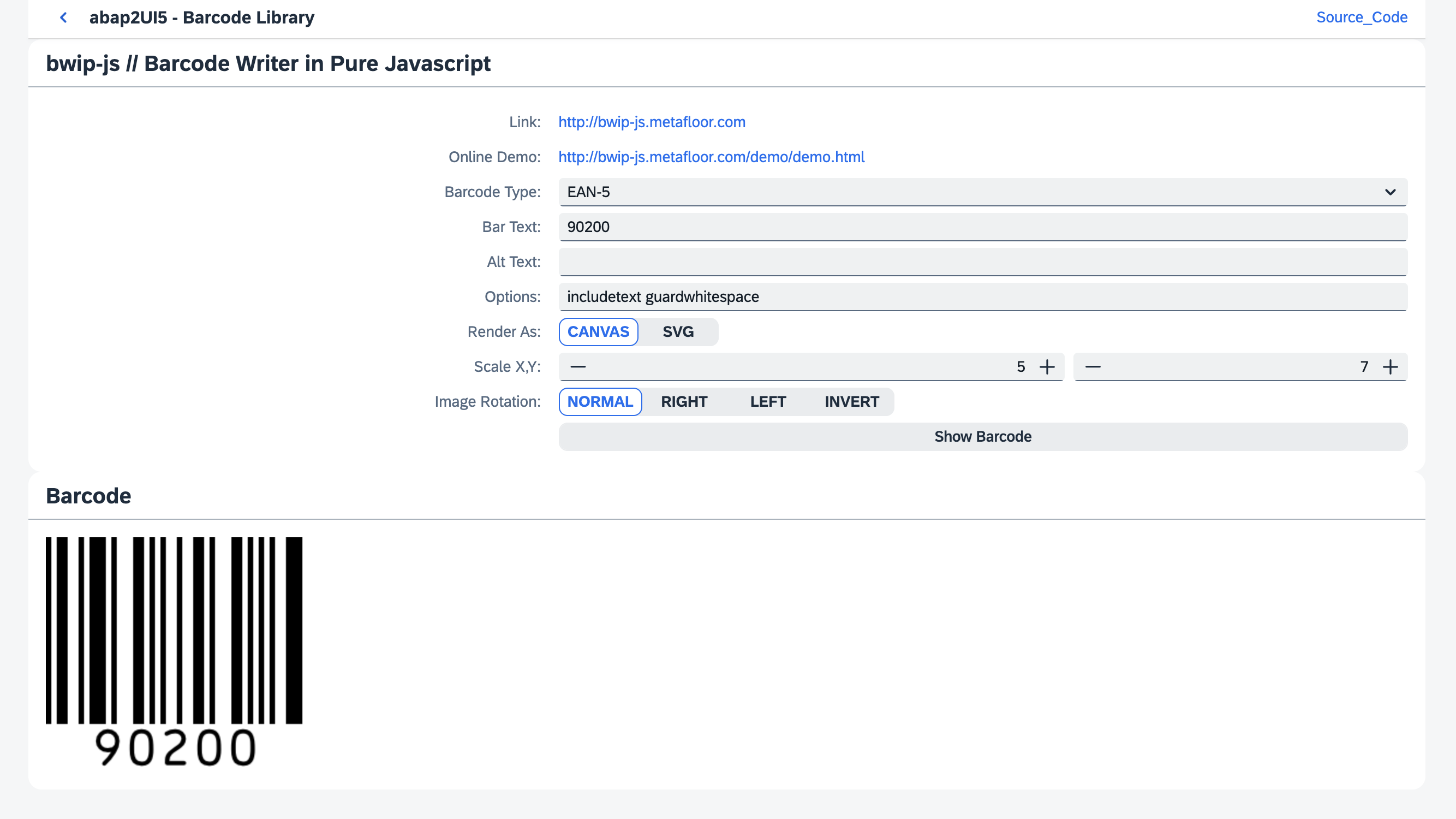
bwip-js integrated in abap2UI5
This encapsulation allows abap2UI5 app developers to easily utilize bwip-js features through properties, similar to how they do with any other UI5 control. The complexity of the bwip-js framework stays in the custom control, simplifying development at the app level. Take a look at the following view definition, which generates the barcode at the frontend:
cont->simple_form( title = 'Barcode' editable = abap_true
)->_z2ui5( )->bwip_js(
bcid = ms_barcode-sym
text = ms_barcode-text
scale = mv_scale_x
height = conv string( mv_scale_y + mv_scale_x ) ).The bwip-js demo in action looks like this:
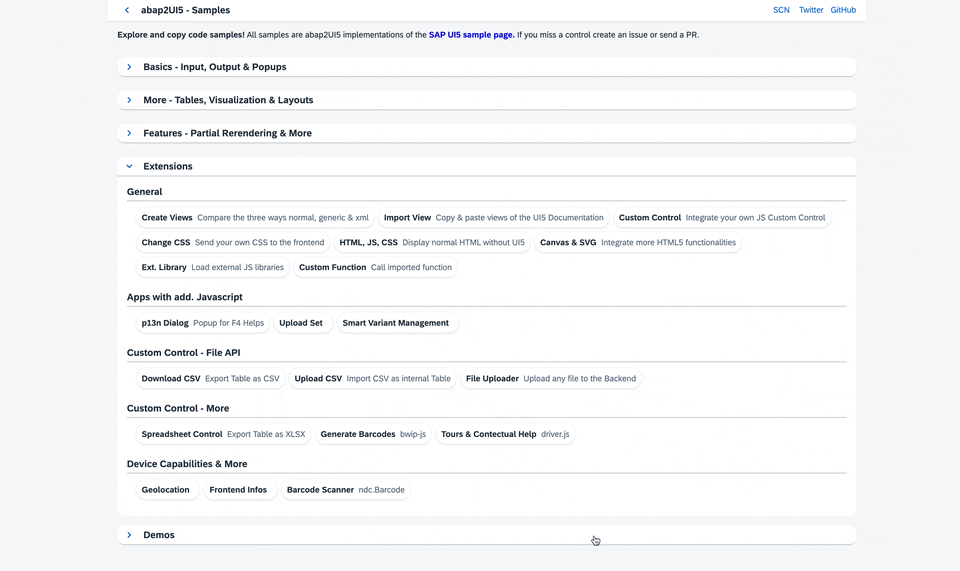
abap2UI5 App in Action: Displaying Barcodes Using bwip-js
As you can observe, it resembles the original demo, but it is now fully integrated into abap2UI5, allowing bwip-js to be used entirely in pure ABAP. The app's source code comprises just 137 lines. You can view the full example on GitHub:

Source Code for Displaying Barcodes in Pure ABAP with abap2UI5 (here)
The bwip-js library and the Custom Control's code are loaded beforehand. This is done as follows:
cont->_generic( ns = `html` name = `script` )->_cc_plain_xml( z2ui5_cl_cc_bwipjs=>get_js( ) ).This loading process occurs at the app level to minimize the framework's load time at startup and ensure it is only loaded when necessary. Alternatively, the loading can also be initiated at the framework's start. An importing parameter is available for loading custom JavaScript at startup here. Some Custom Controls with basic functionality are always preloaded, as you can find here.
(2) Scan Barcodes with the UI5 Barcode Scanner
Displaying barcodes is useful, but their functionality is limited without the ability to scan them. Initially, UI5 lacked native barcode scanning capabilities. This gap was bridged by developing custom controls to integrate libraries like Zbar, ScanBot, or Quagga.js into UI5. However, in recent years, this additional effort has become redundant as UI5 now incorporates scanner libraries built upon the zxing scanner engine. These functionalities are encapsulated within the sap.ndc.BarcodeScanner controls. Check out the samples here:

UI5 Barcode Scanner Control
This integration allows them to run seamlessly with both UI5 and abap2UI5 right out of the box. We can simply use this UI5 Control in our view as follows:
)->barcodescannerbutton(
scansuccess = client->_event(
val = 'ON_SCAN_SUCCESS'
t_arg = VALUE #( ( `${$parameters>/text}` )
( `${$parameters>/format}` ) ) )
dialogtitle = `Barcode Scanner` ).
After each button click, a popup appears, allowing you to scan. The scanned format and text are then sent with the event "ScanSuccess" to the backend. See this demo, recorded on an iPhone:

abap2UI5 App in Action: Scanning QR-Codes (Running on an iPhone)
Similar to the first example, we can access the entire functionality through the properties of the UI5 control. This simplifies its use with abap2UI5, and only a small implementation logic is required for the above example. You can find the full source code on GitHub:

Source Code for Scanning Barcodes in Pure ABAP with abap2UI5 (here)
(3) Read Frontend & Device Information
Sometimes, you may want to respond within the application based on specific factors like the actual device, UI5 library version, or other frontend information. We can easily send this information to the backend, enabling you to respond in the ABAP code to certain situations. You can obtain some information using the following method:

abap2UI5 - Return Values of the Method client->get( )
Additionally, the framework now features a custom control, included here, to read more information from the frontend. Explore this demo:

abap2UI5 - Read Frontend Information via Custom Control
It can be utilized in the same manner as all other UI5 Controls, as demonstrated here:
client->view_display( view->shell(
)->page( title = 'abap2UI5'
)->_z2ui5( )->info_frontend(
finished = client->_event( `INFO_FINISHED` )
device_browser = client->_bind_edit( device_browser )
device_os = client->_bind_edit( device_os )
device_systemtype = client->_bind_edit( device_systemtype )
ui5_gav = client->_bind_edit( ui5_gav )
ui5_theme = client->_bind_edit( ui5_theme )
ui5_version = client->_bind_edit( ui5_version )
)->stringify( ) ).Explore the full source code on GitHub:

Source Code for Reading Frontend Information in Pure ABAP with abap2UI5 (here)
Further enhancements can be added in the future.
(4) Reading Geolocation & Visualizing with the UI5 Map Control
The frontend's geolocation can be accessed using the Geolocation API. For example, the source code for the frontend might look as follows:
<script>
const x = document.getElementById("demo");
function getLocation() {
if (navigator.geolocation) {
navigator.geolocation.getCurrentPosition(showPosition);
} else {
x.innerHTML = "Geolocation is not supported by this browser.";
}
}
function showPosition(position) {
x.innerHTML = "Latitude: " + position.coords.latitude +
"<br>Longitude: " + position.coords.longitude;
}
</script>For integration with abap2UI5, the following custom control encapsulates this functionality and it can be utilized in a view definition like this:
)->_z2ui5( )->geolocation(
finished = client->_event( )
longitude = client->_bind_edit( longitude )
latitude = client->_bind_edit( latitude )
altitude = client->_bind_edit( altitude )
altitudeaccuracy = client->_bind_edit( altitudeaccuracy )
accuracy = client->_bind_edit( accuracy )
speed = client->_bind_edit( speed )It reads out the latitude, longitude, etc.:

abap2UI5 App in Action: Calling the Geolocation API at the Frontend
However, it becomes fascinating when visualized on a map. While options like Google Maps or OpenStreetMap are available, we opt for a simpler approach by just integrating the UI5 Map Container Control into abap2UI5. Check out the control samples here:

UI5 Map Container Control
The Map Container Control in an abap2UI5 view looks like this:
)->map_container( autoadjustheight = abap_true
)->content( ns = `vk`
)->container_content(
title = `Analytic Map`
icon = `sap-icon://geographic-bubble-chart`
)->content( ns = `vk`
)->analytic_map(
initialposition = `9.933573;50;0`
initialzoom = `6`
)->vos(
)->spots( client->_bind( mt_spot )
)->spot(
position = `{POS}`
contentoffset = `{CONTENTOFFSET}`
type = `{TYPE}`
scale = `{SCALE}`
tooltip = `{TOOLTIP}`And here is a demo combining the Geolocation and UI5 Map Container in a single, integrated example:

abap2UI5 App in Action: Geolocation Information Visualized with the UI5 Map Container
Explore the full source code of the demo on GitHub:
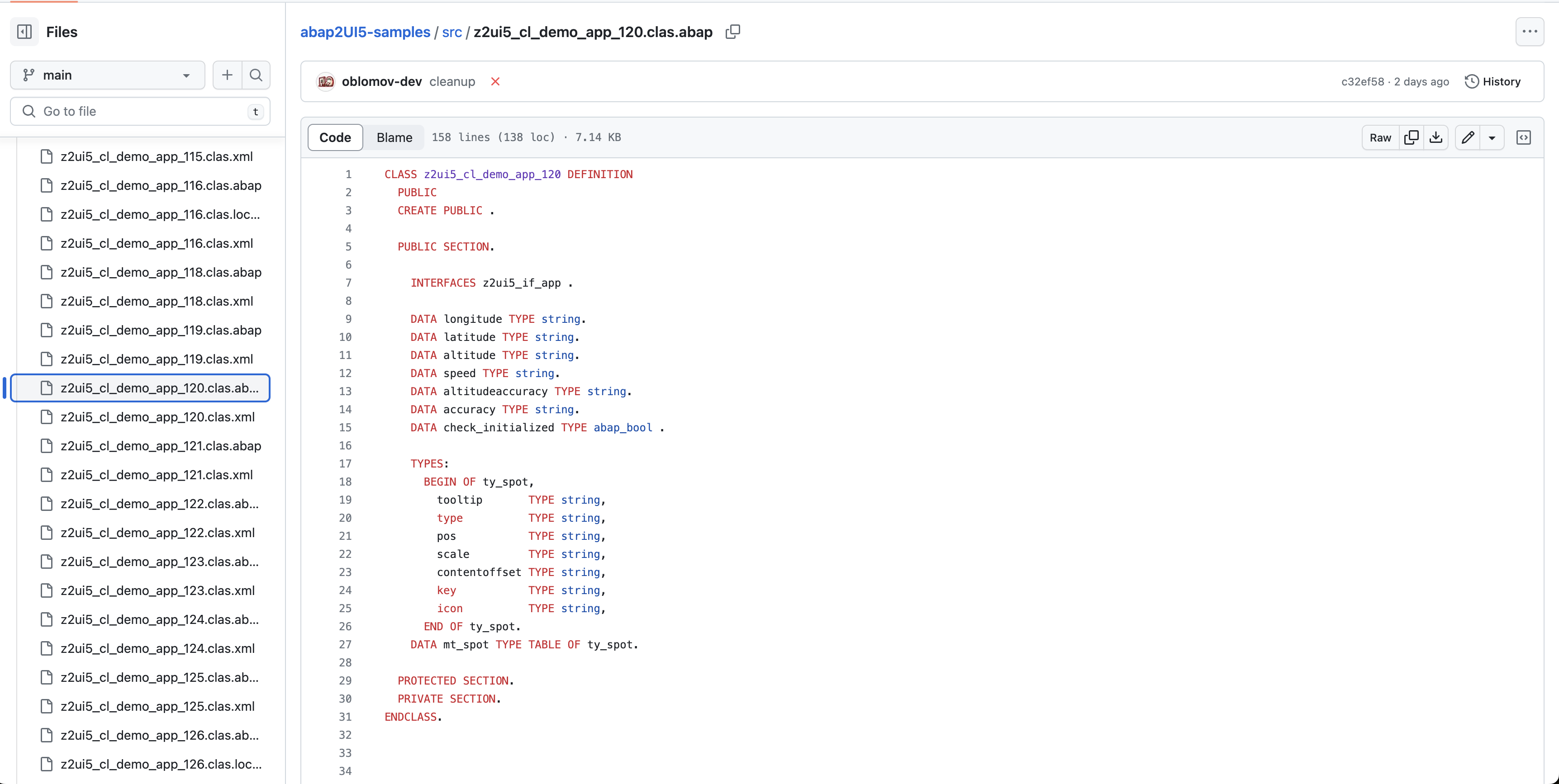
Source Code for Reading and Displaying the Geolocation in Pure ABAP with abap2UI5 (here)
The map container also offers a lot more functionality - it's possible to display multiple spots or visualize complete routes:

UI5 Map Container Control - More Features
(5) Capturing Pictures
Capturing screenshots in modern browsers is accomplished using the Media Capture and Streams API. Similar to previous examples, for integration with abap2UI5, we encapsulate this functionality in a custom control, as shown here. It can be utilized in a view definition as follows:
page->_z2ui5( )->camera_picture(
value = client->_bind_edit( mv_picture_base )
onphoto = client->_event( 'CAPTURE' ) ).We send a user command to the backend with the event "onPhoto" and use a two-way binding for the data of the picture. This means when a picture is taken, it's transmitted to the backend in base64 format. To avoid unnecessary data transfer, we immediately clear this property and only send the picture to the frontend when it's needed:
CASE client->get( )-event.
WHEN 'CAPTURE'.
INSERT VALUE #( data = mv_picture_base time = sy-uzeit ) INTO TABLE mt_picture.
CLEAR mv_picture_base.
client->view_model_update( ).
"....
ENDCASE.A complete demo looks as follows:

abap2UI5 App in Action: Capturing Pictures (Running on an iPad Mini)
Again, the encapsulation into a custom control keeps the abap2UI5 app compact, requiring only 120 lines of code. You can view the complete source code on GitHub:

Source Code for Capturing Pictures in Pure ABAP with abap2UI5 (here)
This only represents the basic functionality of the Camera API at the frontend. Looking ahead, there's potential to upgrade the Custom Control to alter resolution or more camera settings. Although this app served primarily as a test case, photos frequently prove invaluable in business contexts, especially for documentation purposes. Whether they are stored as GOS attachments in an on-premise system or used with SAP BTP Document Management Service in cloud scenarios, you can also consider implementing these use cases with abap2UI5.
(6) Highlights & Contextual Help with driver.js
A few weeks ago, I received an excellent pull request from choper725. It introduced the JavaScript framework driver.js designed to present contextual help or highlight specific areas of the screen as user guidance. Check out the framework here:

JavaScript Framework driver.js
This framework can be seamlessly integrated into abap2UI5. Here's what the demo looks like:

abap2UI5 App in Action: Highlights & Contextual Help with driver.js
The full source code is available on GitHub:

Source Code for Using driver.js in Pure ABAP with abap2UI5 (here)
In this example, only basic functionality is implemented, but it effectively showcases its potential. The combination of UI5 together with driver.js opens up various additional use cases for the future.
Special thanks to choper725 for contributing this custom control and demo to abap2UI5. Another addition from him is Font Awesome and ImageMapster, which we will explore next.
(7) More Libraries...
There is a wide range of libraries compatible with both UI5 and abap2UI5. To see what has been integrated thus far, you can visit this folder. Smaller libraries can also be quite useful for specific use cases. As an final example, let's take a look at the Font Awesome icons here:
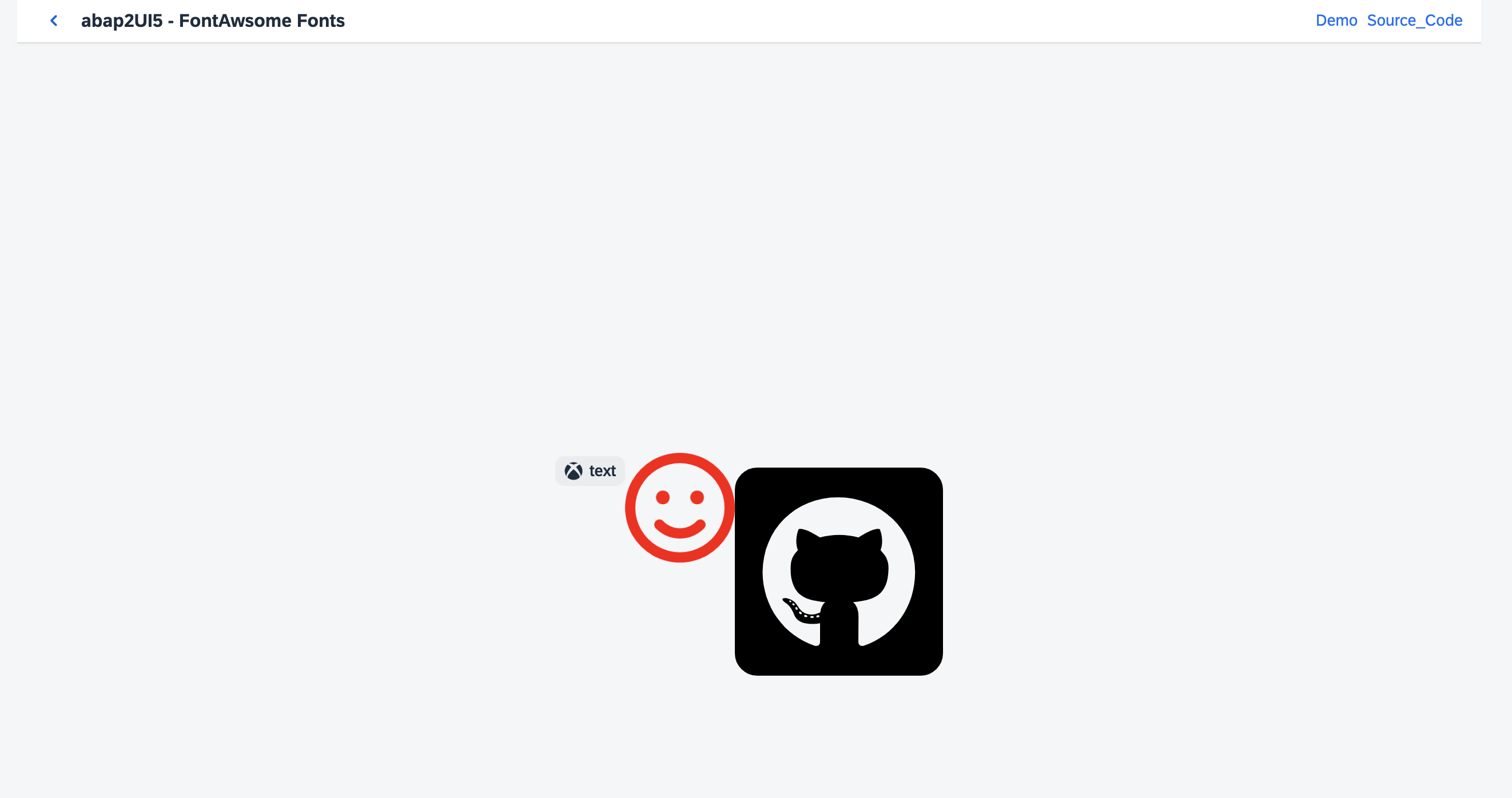
abap2UI5 App using Font Awesome
And check out the full source code on GitHub:

Source Code of Font Awesome used with abap2UI5 (here)
Or take a look to the ImageMapster Example:

abap2UI5 App using ImageMapster
It can handle Events by clicking on certain Image areas, check out the full source code on GitHub:

Source Code of ImageMapster used with abap2UI5 (here)
And finally check out Animate.css:

abap2UI5 App using animate.css
And check out the source code on GitHub:

Source Code of animate.css used with abap2UI5 (here)
Conclusion
It was exciting to experiment with all these features to explore what's possible with the abap2UI5 approach. Although this was just a start, and much more can be developed in the future, it already showcases its potential: The use of native device capabilities with external libraries encapsulated within custom controls allows straightforward accessibility through properties in pure ABAP. It opens up a lot of use cases while keeping the development effort on app level very low.
All these features have now been integrated into the abap2UI5 framework and are ready to run out-of-the-box after installation with abapGit. Storing JavaScript in ABAP classes may seem unconventional, but it ensures full compatibility across any ABAP system and language version. This strategy eliminates the need for deployment of additional frontend artifacts or further configurations beyond the ABAP source code. Additionally, all applications developed using these functionalities also automatically qualify as abapGit apps, facilitating easy transport and exchange between systems.
Are you using external libraries with UI5? Consider contributing them to abap2UI5, I always welcome new pull requests and have recently updated the repository to streamline the process of adding new custom controls.
In the next part, you find a guideline of how to include your own JavaScript functionality to abap2UI5.
Thank you for reading and I hope you enjoy experimenting with the new demos. Your feedback is always appreciated. Feel free to raise an issue or leave a comment.
- SAP Managed Tags:
- SAP BTP, ABAP environment,
- SAP Fiori,
- ABAP Development,
- SAPUI5,
- SAP R/3,
- SAP S/4HANA
You must be a registered user to add a comment. If you've already registered, sign in. Otherwise, register and sign in.
-
"automatische backups"
1 -
"regelmäßige sicherung"
1 -
"TypeScript" "Development" "FeedBack"
1 -
505 Technology Updates 53
1 -
ABAP
18 -
ABAP API
1 -
ABAP CDS Views
4 -
ABAP CDS Views - BW Extraction
1 -
ABAP CDS Views - CDC (Change Data Capture)
1 -
ABAP class
2 -
ABAP Cloud
3 -
ABAP DDIC CDS view
1 -
ABAP Development
5 -
ABAP in Eclipse
3 -
ABAP Platform Trial
1 -
ABAP Programming
2 -
abap technical
1 -
abapGit
1 -
absl
2 -
access data from SAP Datasphere directly from Snowflake
1 -
Access data from SAP datasphere to Qliksense
1 -
Accrual
1 -
action
1 -
adapter modules
1 -
Addon
1 -
Adobe Document Services
1 -
ADS
1 -
ADS Config
1 -
ADS with ABAP
1 -
ADS with Java
1 -
ADT
2 -
Advance Shipping and Receiving
1 -
Advanced Event Mesh
3 -
Advanced formula
1 -
AEM
1 -
AI
8 -
AI Launchpad
1 -
AI Projects
1 -
AIML
10 -
Alert in Sap analytical cloud
1 -
Amazon S3
1 -
Analytic Models
1 -
Analytical Dataset
1 -
Analytical Model
1 -
Analytics
1 -
Analyze Workload Data
1 -
annotations
1 -
API
1 -
API and Integration
4 -
API Call
2 -
API security
1 -
Application Architecture
1 -
Application Development
5 -
Application Development for SAP HANA Cloud
3 -
Applications and Business Processes (AP)
1 -
Artificial Intelligence
1 -
Artificial Intelligence (AI)
5 -
Artificial Intelligence (AI) 1 Business Trends 363 Business Trends 8 Digital Transformation with Cloud ERP (DT) 1 Event Information 462 Event Information 15 Expert Insights 114 Expert Insights 76 Life at SAP 418 Life at SAP 1 Product Updates 4
1 -
Artificial Intelligence (AI) blockchain Data & Analytics
1 -
Artificial Intelligence (AI) blockchain Data & Analytics Intelligent Enterprise
1 -
Artificial Intelligence (AI) blockchain Data & Analytics Intelligent Enterprise Oil Gas IoT Exploration Production
1 -
Artificial Intelligence (AI) blockchain Data & Analytics Intelligent Enterprise sustainability responsibility esg social compliance cybersecurity risk
1 -
AS Java
1 -
ASE
1 -
ASR
2 -
Asset Management
2 -
Associations in CDS Views
1 -
ASUG
1 -
Attachments
1 -
Authentication
1 -
Authorisations
1 -
Automating Processes
1 -
Automation
2 -
aws
2 -
Azure
2 -
Azure AI Studio
1 -
Azure API Center
1 -
Azure API Management
1 -
B2B Integration
1 -
Background job
1 -
Backorder Processing
1 -
Backpropagation
1 -
Backup
1 -
Backup and Recovery
1 -
Backup schedule
1 -
BADI_MATERIAL_CHECK error message
1 -
Bank
1 -
Bank Communication Management
1 -
BAS
1 -
basis
2 -
Basis Monitoring & Tcodes with Key notes
2 -
Batch Management
1 -
BDC
1 -
Best Practice
1 -
BI
1 -
bitcoin
1 -
Blockchain
3 -
bodl
1 -
BOP in aATP
1 -
BOP Segments
1 -
BOP Strategies
1 -
BOP Variant
1 -
BPC
1 -
BPC LIVE
1 -
BTP
15 -
BTP AI Launchpad
1 -
BTP Destination
2 -
Business AI
1 -
Business and IT Integration
1 -
Business application stu
1 -
Business Application Studio
1 -
Business Architecture
1 -
Business Communication Services
1 -
Business Continuity
2 -
Business Data Fabric
3 -
Business Fabric
1 -
Business Partner
13 -
Business Partner Master Data
11 -
Business Technology Platform
2 -
Business Trends
4 -
BW4HANA
1 -
CA
1 -
calculation view
1 -
CAP
4 -
Capgemini
1 -
CAPM
1 -
Catalyst for Efficiency: Revolutionizing SAP Integration Suite with Artificial Intelligence (AI) and
1 -
CCMS
2 -
CDQ
13 -
CDS
2 -
CDS Views
1 -
Cental Finance
1 -
Certificates
1 -
CFL
1 -
Change Management
1 -
chatbot
1 -
chatgpt
3 -
CICD
1 -
CL_SALV_TABLE
2 -
Class Runner
1 -
Classrunner
1 -
Cloud ALM Monitoring
1 -
Cloud ALM Operations
1 -
cloud connector
1 -
Cloud Extensibility
1 -
Cloud Foundry
4 -
Cloud Integration
6 -
Cloud Platform Integration
2 -
cloudalm
1 -
communication
1 -
Compensation Information Management
1 -
Compensation Management
1 -
Compliance
1 -
Compound Employee API
1 -
Configuration
1 -
Connectors
1 -
Consolidation
1 -
Consolidation Extension for SAP Analytics Cloud
3 -
Control Indicators.
1 -
Controller-Service-Repository pattern
1 -
Conversion
1 -
Corrective Maintenance
1 -
Cosine similarity
1 -
CPI
1 -
cryptocurrency
1 -
CSI
1 -
ctms
1 -
Custom chatbot
3 -
Custom Destination Service
1 -
custom fields
1 -
Custom Headers
1 -
Customer Experience
1 -
Customer Journey
1 -
Customizing
1 -
cyber security
5 -
cybersecurity
1 -
Data
1 -
Data & Analytics
1 -
Data Aging
1 -
Data Analytics
2 -
Data and Analytics (DA)
1 -
Data Archiving
1 -
Data Back-up
1 -
Data Flow
1 -
Data Governance
5 -
Data Integration
2 -
Data Quality
13 -
Data Quality Management
13 -
Data Synchronization
1 -
data transfer
1 -
Data Unleashed
1 -
Data Value
9 -
Database and Data Management
1 -
database tables
1 -
Databricks
1 -
Dataframe
1 -
Datasphere
3 -
Datasphere Delta
1 -
datenbanksicherung
1 -
dba cockpit
1 -
dbacockpit
1 -
Debugging
2 -
Defender
1 -
Delimiting Pay Components
1 -
Delta Integrations
1 -
Destination
3 -
Destination Service
1 -
Developer extensibility
1 -
Developing with SAP Integration Suite
1 -
Devops
1 -
digital transformation
1 -
Disaster Recovery
1 -
Documentation
1 -
Dot Product
1 -
DQM
1 -
dump database
1 -
dump transaction
1 -
e-Invoice
1 -
E4H Conversion
1 -
Eclipse ADT ABAP Development Tools
2 -
edoc
1 -
edocument
1 -
ELA
1 -
Embedded Consolidation
1 -
Embedding
1 -
Embeddings
1 -
Emergency Maintenance
1 -
Employee Central
1 -
Employee Central Payroll
1 -
Employee Central Time Off
1 -
Employee Information
1 -
Employee Rehires
1 -
Enable Now
1 -
Enable now manager
1 -
endpoint
1 -
Enhancement Request
1 -
Enterprise Architecture
1 -
Enterprise Asset Management
2 -
Entra
1 -
ESLint
1 -
ETL Business Analytics with SAP Signavio
1 -
Euclidean distance
1 -
Event Dates
1 -
Event Driven Architecture
1 -
Event Mesh
2 -
Event Reason
1 -
EventBasedIntegration
1 -
EWM
1 -
EWM Outbound configuration
1 -
EWM-TM-Integration
1 -
Existing Event Changes
1 -
Expand
1 -
Expert
2 -
Expert Insights
2 -
Exploits
1 -
Fiori
16 -
Fiori App Extension
2 -
Fiori Elements
2 -
Fiori Launchpad
2 -
Fiori SAPUI5
13 -
first-guidance
1 -
Flask
2 -
FTC
1 -
Full Stack
9 -
Funds Management
1 -
gCTS
1 -
GenAI hub
1 -
General
3 -
Generative AI
1 -
Getting Started
1 -
GitHub
11 -
Google cloud
1 -
Grants Management
1 -
groovy
2 -
GTP
1 -
HANA
6 -
HANA Cloud
2 -
Hana Cloud Database Integration
2 -
HANA DB
2 -
Hana Vector Engine
1 -
HANA XS Advanced
1 -
Historical Events
1 -
home labs
1 -
HowTo
1 -
HR Data Management
1 -
html5
9 -
HTML5 Application
1 -
Identity cards validation
1 -
idm
1 -
Implementation
1 -
Improvement Maintenance
1 -
Infuse AI
1 -
input parameter
1 -
instant payments
1 -
Integration
3 -
Integration Advisor
1 -
Integration Architecture
1 -
Integration Center
1 -
Integration Suite
1 -
intelligent enterprise
1 -
Internal Table
1 -
IoT
2 -
Java
1 -
JMS Receiver channel ping issue
1 -
job
1 -
Job Information Changes
1 -
Job-Related Events
1 -
Job_Event_Information
1 -
joule
4 -
Journal Entries
1 -
Just Ask
1 -
Kafka
1 -
Kerberos for ABAP
10 -
Kerberos for JAVA
9 -
KNN
1 -
Launch Wizard
1 -
Learning Content
3 -
Life at SAP
5 -
lightning
1 -
Linear Regression SAP HANA Cloud
1 -
Live Sessions
1 -
Loading Indicator
1 -
local tax regulations
1 -
LP
1 -
Machine Learning
4 -
Marketing
1 -
Master Data
3 -
Master Data Management
15 -
Maxdb
2 -
MDG
1 -
MDGM
1 -
MDM
1 -
Message box.
1 -
Messages on RF Device
1 -
Microservices Architecture
1 -
Microsoft
1 -
Microsoft Universal Print
1 -
Middleware Solutions
1 -
Migration
5 -
ML Model Development
1 -
MLFlow
1 -
Modeling in SAP HANA Cloud
9 -
Monitoring
3 -
MPL
1 -
MTA
1 -
Multi-factor-authentication
1 -
Multi-Record Scenarios
1 -
Multilayer Perceptron
1 -
Multiple Event Triggers
1 -
Myself Transformation
1 -
Neo
1 -
Neural Networks
1 -
New Event Creation
1 -
New Feature
1 -
Newcomer
1 -
NodeJS
3 -
ODATA
2 -
OData APIs
1 -
odatav2
1 -
ODATAV4
1 -
ODBC
1 -
ODBC Connection
1 -
Onpremise
1 -
open source
2 -
OpenAI API
1 -
Oracle
1 -
Overhead and Operational Maintenance
1 -
PaPM
1 -
PaPM Dynamic Data Copy through Writer function
1 -
PaPM Remote Call
1 -
Partner Built Foundation Model
1 -
PAS-C01
1 -
Pay Component Management
1 -
PGP
1 -
Pickle
1 -
PLANNING ARCHITECTURE
1 -
Plant Maintenance
2 -
Popup in Sap analytical cloud
1 -
PostgrSQL
1 -
POSTMAN
1 -
Practice Systems
1 -
Prettier
1 -
Proactive Maintenance
1 -
Process Automation
2 -
Product Updates
6 -
PSM
1 -
Public Cloud
1 -
Python
5 -
python library - Document information extraction service
1 -
Qlik
1 -
Qualtrics
1 -
RAP
3 -
RAP BO
2 -
React
1 -
Reactive Maintenance
2 -
Record Deletion
1 -
Recovery
1 -
recurring payments
1 -
redeply
1 -
Release
1 -
Remote Consumption Model
1 -
Replication Flows
1 -
Report Malfunction
1 -
report painter
1 -
research
1 -
Resilience
1 -
REST
1 -
REST API
1 -
Retagging Required
1 -
RFID
1 -
Risk
1 -
rolandkramer
2 -
Rolling Kernel Switch
1 -
route
1 -
rules
1 -
S4 HANA
2 -
S4 HANA Cloud
2 -
S4 HANA On-Premise
3 -
S4HANA
6 -
S4HANA Cloud
1 -
S4HANA_OP_2023
2 -
SAC
11 -
SAC PLANNING
10 -
SAP
4 -
SAP ABAP
1 -
SAP Advanced Event Mesh
2 -
SAP AI Core
10 -
SAP AI Launchpad
9 -
SAP Analytic Cloud
1 -
SAP Analytic Cloud Compass
1 -
Sap Analytical Cloud
1 -
SAP Analytics Cloud
5 -
SAP Analytics Cloud for Consolidation
3 -
SAP Analytics cloud planning
1 -
SAP Analytics Cloud Story
1 -
SAP analytics clouds
1 -
SAP API Management
1 -
SAP Application Logging Service
1 -
SAP BAS
1 -
SAP Basis
6 -
SAP BO FC migration
1 -
SAP BODS
1 -
SAP BODS certification.
1 -
SAP BODS migration
1 -
SAP BPC migration
1 -
SAP BTP
25 -
SAP BTP Build Work Zone
2 -
SAP BTP Cloud Foundry
8 -
SAP BTP Costing
1 -
SAP BTP CTMS
1 -
SAP BTP Generative AI
1 -
SAP BTP Innovation
1 -
SAP BTP Migration Tool
1 -
SAP BTP SDK IOS
1 -
SAP BTPEA
1 -
SAP Build
12 -
SAP Build App
1 -
SAP Build apps
1 -
SAP Build CodeJam
1 -
SAP Build Process Automation
3 -
SAP Build work zone
11 -
SAP Business Objects Platform
1 -
SAP Business Technology
2 -
SAP Business Technology Platform (XP)
1 -
sap bw
1 -
SAP CAP
2 -
SAP CDC
1 -
SAP CDP
1 -
SAP CDS VIEW
1 -
SAP Certification
1 -
SAP Cloud ALM
4 -
SAP Cloud Application Programming Model
1 -
SAP Cloud Integration
1 -
SAP Cloud Integration for Data Services
1 -
SAP cloud platform
9 -
SAP Companion
1 -
SAP CPI
3 -
SAP CPI (Cloud Platform Integration)
2 -
SAP CPI Discover tab
1 -
sap credential store
1 -
SAP Customer Data Cloud
1 -
SAP Customer Data Platform
1 -
SAP Data Intelligence
1 -
SAP Data Migration in Retail Industry
1 -
SAP Data Services
1 -
SAP DATABASE
1 -
SAP Dataspher to Non SAP BI tools
1 -
SAP Datasphere
9 -
SAP DRC
1 -
SAP EWM
1 -
SAP Fiori
3 -
SAP Fiori App Embedding
1 -
Sap Fiori Extension Project Using BAS
1 -
SAP GRC
1 -
SAP HANA
1 -
SAP HANA PAL
1 -
SAP HANA Vector
1 -
SAP HCM (Human Capital Management)
1 -
SAP HR Solutions
1 -
SAP IDM
1 -
SAP Integration Suite
10 -
SAP Integrations
4 -
SAP iRPA
2 -
SAP LAGGING AND SLOW
1 -
SAP Learning Class
2 -
SAP Learning Hub
1 -
SAP Master Data
1 -
SAP Odata
3 -
SAP on Azure
2 -
SAP PAL
1 -
SAP PartnerEdge
1 -
sap partners
1 -
SAP Password Reset
1 -
SAP PO Migration
1 -
SAP Prepackaged Content
1 -
sap print
1 -
SAP Process Automation
2 -
SAP Process Integration
2 -
SAP Process Orchestration
1 -
SAP Router
1 -
SAP S4HANA
2 -
SAP S4HANA Cloud
3 -
SAP S4HANA Cloud for Finance
1 -
SAP S4HANA Cloud private edition
1 -
SAP Sandbox
1 -
SAP STMS
1 -
SAP successfactors
3 -
SAP SuccessFactors HXM Core
1 -
SAP Time
1 -
SAP TM
2 -
SAP Trading Partner Management
1 -
SAP UI5
1 -
SAP Upgrade
1 -
SAP Utilities
1 -
SAP-GUI
9 -
SAP_COM_0276
1 -
SAPBTP
1 -
SAPCPI
1 -
SAPEWM
1 -
sapfirstguidance
3 -
SAPHANAService
1 -
SAPIQ
2 -
sapmentors
1 -
saponaws
2 -
saprouter
1 -
SAPRouter installation
1 -
SAPS4HANA
1 -
SAPUI5
5 -
schedule
1 -
Script Operator
1 -
Secure Login Client Setup
9 -
security
10 -
Selenium Testing
1 -
Self Transformation
1 -
Self-Transformation
1 -
SEN
1 -
SEN Manager
1 -
Sender
1 -
service
2 -
SET_CELL_TYPE
1 -
SET_CELL_TYPE_COLUMN
1 -
SFTP scenario
2 -
Simplex
1 -
Single Sign On
9 -
Singlesource
1 -
SKLearn
1 -
Slow loading
1 -
SOAP
2 -
Software Development
1 -
SOLMAN
1 -
solman 7.2
2 -
Solution Manager
3 -
sp_dumpdb
1 -
sp_dumptrans
1 -
SQL
1 -
sql script
1 -
SSL
9 -
SSO
9 -
Story2
1 -
Substring function
1 -
SuccessFactors
1 -
SuccessFactors Platform
1 -
SuccessFactors Time Tracking
1 -
Sybase
1 -
Synthetic User Monitoring
1 -
system copy method
1 -
System owner
1 -
Table splitting
1 -
Tax Integration
1 -
Technical article
1 -
Technical articles
1 -
Technology Updates
15 -
Technology Updates
1 -
Technology_Updates
1 -
terraform
1 -
Testing
1 -
Threats
2 -
Time Collectors
1 -
Time Off
2 -
Time Sheet
1 -
Time Sheet SAP SuccessFactors Time Tracking
1 -
Tips and tricks
2 -
toggle button
1 -
Tools
1 -
Trainings & Certifications
1 -
Transformation Flow
1 -
Transport in SAP BODS
1 -
Transport Management
1 -
TypeScript
3 -
ui designer
1 -
unbind
1 -
Unified Customer Profile
1 -
UPB
1 -
Use of Parameters for Data Copy in PaPM
1 -
User Unlock
1 -
VA02
1 -
Validations
1 -
Vector Database
2 -
Vector Engine
1 -
Vectorization
1 -
Visual Studio Code
1 -
VSCode
2 -
VSCode extenions
1 -
Vulnerabilities
1 -
Web SDK
1 -
Webhook
1 -
work zone
1 -
workload
1 -
xsa
1 -
XSA Refresh
1
- « Previous
- Next »
- SAP BTP FAQs - Part 2 (Application Development, Programming Models and Multitenancy) in Technology Blogs by SAP
- SAP BTP FAQs - Part 1 (General Topics in SAP BTP) in Technology Blogs by SAP
- DevOps with SAP BTP in Technology Blogs by SAP
- Dynamic Extensions of the Planning Area Defined by the Table Context QRC2 2024 in Technology Blogs by SAP
- Adapt Clean Core Principle using SAP Cloud ALM in Technology Blogs by Members
| User | Count |
|---|---|
| 50 | |
| 5 | |
| 5 | |
| 4 | |
| 4 | |
| 4 | |
| 3 | |
| 3 | |
| 3 | |
| 2 |